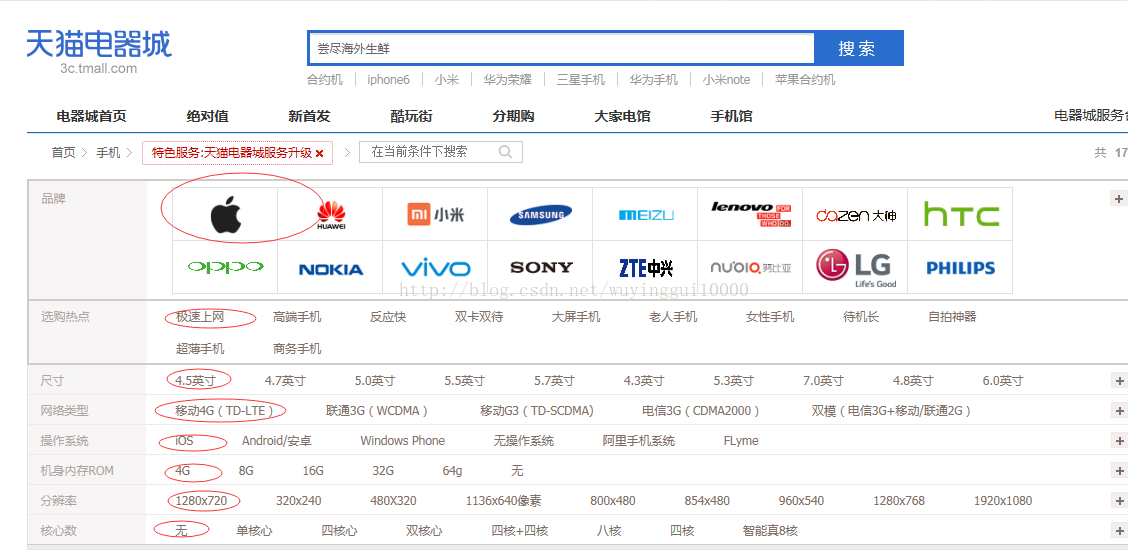Facet说明
我们在浏览网站的时候,经常会遇到按某一类条件查询的情况,这种情况尤以电商网站最多,以天猫商城为例,我们选择某一个品牌,系统会将该品牌对应的商品展示出来,效果图如下:
如上图,我们关注的是品牌,选购热点等方面,对于类似的功能我们用lucene的term查询当然可以,但是在数据量特别大的情况下还用普通查询来实现显然会因为FSDirectory.open等耗时的操作造成查询效率的低下,同时普通查询是全部document都扫描一遍,这样显然造成了查询效率低;
lucene 提供了facet 查询用于对同一类的document进行聚类化,这样在查询的时候先关注某一个方面,这种显然缩小了查询范围,进而提升了查询效率;
facet 是什么?
facet,英文翻译为方面。Lucene中的facet查询其实就是对事物的方面查询。
我们以手机举例。一个手机可以有品牌,型号,运营商等多个facet,不同的facet类型可以组合成不同的手机或者手机的集合。如品牌为小米,运营商为移动构成的就是移动发行的所有小米的手机型号(小米1,小米2,小米3)等。而品牌为小米,型号为小米4构成的手机集合就是小米四的所有运营商发行版(小米4移动版,小米4联通版,小米4电信版等)。我们在对一样事物的搜索时也时常使用这种方式,先确定手机品牌,再逐步对型号,运营商等方面进行限制最终得到想要的结果。
下面介绍怎么在Lucene中如何使用facet
使用方式
facet 模块提供了多个用于处理facet的统计和值处理的方法;
要实现facet的功能,我们需要了解facetField,FacetField定义了dim和此field对应的path,需要特别注意的是我们在做facetField索引的时候,需要事先调用FacetsConfig.build(Document);
FacetField的indexOptions设置为了DOCS_AND_FREQS_AND_POSITIONS的,即既索引又统计出现的频次和出现的位置,这样做主要是为了方便查询和统计;
相应的在存储的时候我们需要利用 FacetsConfig 和 DirectoryTaxonomyWriter;
DirectoryTaxonomyWriter 用来利用 Directory 来存储 Taxono 信息到硬盘;
DirectoryTaxonomyWriter 源码浅析
DirectoryTaxonomyWriter 的构造器如下:
public DirectoryTaxonomyWriter(Directory directory, OpenMode openMode,
TaxonomyWriterCache cache) throws IOException {
dir = directory;
IndexWriterConfig config = createIndexWriterConfig(openMode);
indexWriter = openIndexWriter(dir, config);
// verify (to some extent) that merge policy in effect would preserve category docids
assert !(indexWriter.getConfig().getMergePolicy() instanceof TieredMergePolicy) :
"for preserving category docids, merging none-adjacent segments is not allowed";
// after we opened the writer, and the index is locked, it's safe to check
// the commit data and read the index epoch
openMode = config.getOpenMode();
if (!DirectoryReader.indexExists(directory)) {
indexEpoch = 1;
} else {
String epochStr = null;
Map<String, String> commitData = readCommitData(directory);
if (commitData != null) {
epochStr = commitData.get(INDEX_EPOCH);
}
// no commit data, or no epoch in it means an old taxonomy, so set its epoch to 1, for lack
// of a better value.
indexEpoch = epochStr == null ? 1 : Long.parseLong(epochStr, 16);
}
if (openMode == OpenMode.CREATE) {
++indexEpoch;
}
FieldType ft = new FieldType(TextField.TYPE_NOT_STORED);
ft.setOmitNorms(true);
parentStreamField = new Field(Consts.FIELD_PAYLOADS, parentStream, ft);
fullPathField = new StringField(Consts.FULL, "", Field.Store.YES);
nextID = indexWriter.maxDoc();
if (cache == null) {
cache = defaultTaxonomyWriterCache();
}
this.cache = cache;
if (nextID == 0) {
cacheIsComplete = true;
// Make sure that the taxonomy always contain the root category
// with category id 0.
addCategory(new FacetLabel());
} else {
// There are some categories on the disk, which we have not yet
// read into the cache, and therefore the cache is incomplete.
// We choose not to read all the categories into the cache now,
// to avoid terrible performance when a taxonomy index is opened
// to add just a single category. We will do it later, after we
// notice a few cache misses.
cacheIsComplete = false;
}
}
由上述代码可知,DirectoryTaxonomyWriter先打开一个IndexWriter,在确保indexWriter打开和locked的前提下,读取directory对应的segments中需要提交的内容,如果读取到的内容为空,说明是上次的内容,设置indexEpoch为1,接着对cache进行设置;判断directory中是否还包含有document,如果有设置cacheIsComplete为false,反之为true;
编程实战
maven
引入依赖:
<!--引入方面查询(facet search)的依赖-->
<!-- https://mvnrepository.com/artifact/org.apache.lucene/lucene-facet -->
<dependency>
<groupId>org.apache.lucene</groupId>
<artifactId>lucene-facet</artifactId>
<version>7.2.1</version>
</dependency>
创建索引
建立普通索引的同时建立 TaxonomyIndex(分类索引)
public static void buildIndex(String indexDir, String taxoDir) throws Exception{
Directory directory = FSDirectory.open(Paths.get(indexDir));
IndexWriter writer = new IndexWriter(directory, new IndexWriterConfig(new WhitespaceAnalyzer()));
//使用DirectoryTaxonomyWriter写入进行切面查询所需要的Taxonomy索引
Directory taxioDirectory = FSDirectory.open(Paths.get(taxoDir));
DirectoryTaxonomyWriter taxoWriter = new DirectoryTaxonomyWriter(taxioDirectory);
FacetsConfig config = new FacetsConfig();
Document doc = new Document();
doc.add(new TextField("device", "手机", Field.Store.YES));
doc.add(new TextField("name", "米1", Field.Store.YES));
doc.add(new FacetField("brand", "小米"));
doc.add(new FacetField("network", "移动4G"));
//写入索引的同时写入taxo索引
writer.addDocument(config.build(taxoWriter, doc));
doc = new Document();
doc.add(new TextField("device", "手机", Field.Store.YES));
doc.add(new TextField("name", "米4", Field.Store.YES));
doc.add(new FacetField("brand", "小米"));
doc.add(new FacetField("network", "联通4G"));
writer.addDocument(config.build(taxoWriter, doc));
doc = new Document();
doc.add(new TextField("device", "手机", Field.Store.YES));
doc.add(new TextField("name", "荣耀6", Field.Store.YES));
doc.add(new FacetField("brand", "华为"));
doc.add(new FacetField("network", "移动4G"));
writer.addDocument(config.build(taxoWriter, doc));
doc = new Document();
doc.add(new TextField("device", "电视", Field.Store.YES));
doc.add(new TextField("name", "小米电视2", Field.Store.YES));
doc.add(new FacetField("brand", "小米"));
writer.addDocument(config.build(taxoWriter, doc));
writer.close();
taxoWriter.close();
}
索引查询
对facet查询进行测试,实现如下:
public static void testFacetSearch(String indexDir, String taxoDir) throws Exception{
Directory directory = FSDirectory
.open(Paths.get(indexDir));
DirectoryReader indexReader = DirectoryReader.open(directory);
IndexSearcher searcher = new IndexSearcher(indexReader);
//同时还需要taxonomy reader
Directory taxoDirectory = FSDirectory
.open(Paths.get(taxoDir));
TaxonomyReader taxoReader = new DirectoryTaxonomyReader(taxoDirectory);
FacetsConfig config = new FacetsConfig();
//相应的Collector是必不可少的
FacetsCollector facetsCollector = new FacetsCollector();
//按照手机这个维度查询
System.out.println("---------手机----------");
TermQuery query = new TermQuery(new Term("device", "手机"));
TopDocs docs = FacetsCollector.search(searcher, query, 10, facetsCollector);
printDocs(docs, searcher);
System.out.println("----------facet-----------");
Facets facets = new FastTaxonomyFacetCounts(taxoReader, config, facetsCollector);
List<FacetResult> results = facets.getAllDims(10);
//打印其他维度信息
for (FacetResult tmp : results){
System.out.println(tmp);
}
System.out.println("=======================");
//2.drill down,品牌选小米
System.out.println("-----小米手机-----");
DrillDownQuery drillDownQuery = new DrillDownQuery(config, query);
drillDownQuery.add("brand", "小米");
//要new新collector,否则会累加
FacetsCollector fc1 = new FacetsCollector();
docs = FacetsCollector.search(searcher, drillDownQuery, 10, fc1);
printDocs(docs, searcher);
System.out.println("----------facet-----------");
facets = new FastTaxonomyFacetCounts(taxoReader, config, fc1);
results = facets.getAllDims(10);
//获得小米手机的分布,总数2个,网络:移动4G 1个,联通4G 1个
for (FacetResult tmp : results) {
System.out.println(tmp);
}
System.out.println("=======================");
//3.drill down,在brand这个facet选择了小米之后继续选择另一个方面network为移动4G
System.out.println("-----移动4G小米手机-----");
//可以看到使用的是同一个DrillDownQuery
drillDownQuery.add("network", "移动4G");
FacetsCollector fc2 = new FacetsCollector();
docs = FacetsCollector.search(searcher, drillDownQuery, 10, fc2);
printDocs(docs, searcher);
System.out.println("----------facet-----------");
facets = new FastTaxonomyFacetCounts(taxoReader, config, fc2);
results = facets.getAllDims(10);
for (FacetResult tmp : results) {
System.out.println(tmp);
}
System.out.println("=======================");
//使用sideWay查看其它平行维度的信息
System.out.println("-----小米手机drill sideways-----");
DrillSideways ds = new DrillSideways(searcher, config, taxoReader);
DrillDownQuery drillDownQuery1 = new DrillDownQuery(config, query);
drillDownQuery1.add("brand", "小米");
DrillSideways.DrillSidewaysResult result = ds.search(drillDownQuery1, 10);
docs = result.hits;
printDocs(docs, searcher);
System.out.println("----------facet-----------");
results = result.facets.getAllDims(10);
for (FacetResult tmp : results) {
System.out.println(tmp);
}
System.out.println("=======================");
indexReader.close();
taxoReader.close();
}
其中输出方法实现如下:
private static void printDocs(TopDocs topDocs, IndexSearcher searcher) throws IOException {
ScoreDoc[] docs = topDocs.scoreDocs;
for (ScoreDoc doc : docs) {
Document document = searcher.doc(doc.doc);
System.out.println(document.get("name"));
}
}
测试代码
测试代码如下:
final String indexDir = "data/facet/index";
final String taxoDir = "data/facet/taxo";
buildIndex(indexDir, taxoDir);
testFacetSearch(indexDir, taxoDir);
输出内容如下:
---------手机----------
米1
米4
荣耀6
----------facet-----------
dim=brand path=[] value=3 childCount=2
小米 (2)
华为 (1)
dim=network path=[] value=3 childCount=2
移动4G (2)
联通4G (1)
=======================
-----小米手机-----
米1
米4
----------facet-----------
dim=brand path=[] value=2 childCount=1
小米 (2)
dim=network path=[] value=2 childCount=2
移动4G (1)
联通4G (1)
=======================
-----移动4G小米手机-----
米1
----------facet-----------
dim=brand path=[] value=1 childCount=1
小米 (1)
dim=network path=[] value=1 childCount=1
移动4G (1)
=======================
-----小米手机drill sideways-----
米1
米4
----------facet-----------
dim=brand path=[] value=3 childCount=2
小米 (2)
华为 (1)
dim=network path=[] value=2 childCount=2
移动4G (1)
联通4G (1)
=======================

